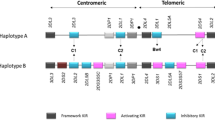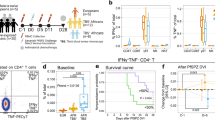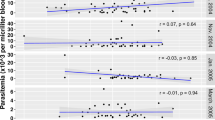Abstract
We examined 906 residents of an area of Papua New Guinea where bancroftian filariasis is endemic for genetic polymorphisms in three innate immunity genes suspected of contributing to susceptibility to infection and lymphatic pathology. Active infection was confirmed by the presence of blood-borne microfilariae and circulating filarial antigen in plasma. Disease was ascertained by physical examination for the presence of overt lymphedema (severe swelling of an arm or leg) or hydrocele. There was no association of infection status, lymphedema of an extremity, or hydrocele with chitotriosidase genotype (CHIT1). Polymorphisms of toll-like receptor-2 and toll-like receptor-4 genes (TLR4 A896G; TLR2 T2178A, G2258A) were not detected (N=200–625 individuals genotyped) except for two individuals heterozygous for a TLR2 mutation (C2029 T). These results indicate that a CHIT1 genotype associated previously with susceptibility to filariasis in residents of southern India and TLR2 and TLR4 polymorphisms do not correlate with infection status or disease phenotype in this Melanesian population.
This is a preview of subscription content, access via your institution
Access options
Subscribe to this journal
Receive 6 digital issues and online access to articles
$119.00 per year
only $19.83 per issue
Buy this article
- Purchase on Springer Link
- Instant access to full article PDF
Prices may be subject to local taxes which are calculated during checkout
Similar content being viewed by others
References
Tisch DJ, Hazlett FE, Kastens W, Alpers MP, Bockarie MJ, Kazura JW . Ecologic and biologic determinants of filarial antigenemia in bancroftian filariasis in Papua New Guinea. J Infect Dis 2001; 184: 898–904.
King CL, Ottesen EA, Nutman TB . Cytokine regulation of antigen-driven immunoglobulin production in filarial parasite infections in humans. J Clin Invest 1990; 85: 1810–1815.
Kazura JW, Bockarie M, Alexander N et al. Transmission intensity and its relationship to infection and disease due to Wuchereria bancrofti in Papua New Guinea. J Infect Dis 1997; 176: 242–246.
Choi EH, Zimmerman PA, Foster CB et al. Genetic polymorphisms in molecules of innate immunity and susceptibility to infection with Wuchereria bancrofti in South India. Genes Immun 2001; 2: 248–253.
Garcia A, Abel L, Cot M et al. Genetic epidemiology of host predisposition microfilaraemia in human loiasis. Trop Med Int Health 1999; 4: 565–574.
Chan SH, Dissanayake S, Mak JW et al. HLA and filariasis in Sri Lankans and Indians. Southeast Asian J Trop Med Public Health 1984; 15: 281–286.
Yazdanbakhsh M, Sartono E, Kruize YC et al. HLA and elephantiasis in lymphatic filariasis. Hum Immunol 1995; 44: 58–61.
Yazdanbakhsh M, Abadi K, de Roo M et al. HLA and elephantiasis revisited. Eur J Immunogenet 1997; 24: 439–442.
Boot RG, Renkema GH, Verhoek M et al. The human chitotriosidase gene. Nature of inherited enzyme deficiency. J Biol Chem 1998; 273: 25680–25685.
Hollak CE, van Weely S, van Oers MH, Aerts JM . Marked elevation of plasma chitotriosidase activity. A novel hallmark of Gaucher disease. J Clin Invest 1994; 93: 1288–1292.
Giraldo P, Cenarro A, Alfonso P et al. Chitotriosidase genotype and plasma activity in patients type 1 Gaucher's disease and their relatives (carriers and non carriers). Haematologica 2001; 86: 977–984.
Masoud M, Rudensky B, Elstein D, Zimran A . Chitotriosidase deficiency in survivors of Candida sepsis. Blood Cells Mol Dis 2002; 29: 116–118.
Canudas J, Cenarro A, Civeira F et al. Chitotriosidase genotype and serum activity in subjects with combined hyperlipidemia: effect of the lipid-lowering agents, atorvastatin and bezafibrate. Metabolism 2001; 50: 447–450.
Taylor MJ, Cross HF, Bilo K . Inflammatory responses induced by the filarial nematode Brugia malayi are mediated by lipopolysaccharide-like activity from endosymbiotic Wolbachia bacteria. J Exp Med 2000; 191: 1429–1436.
Saint Andre A, Blackwell NM, Hall LR et al. The role of endosymbiotic Wolbachia bacteria in the pathogenesis of river blindness. Science 2002; 295: 1892–1895.
Kaisho T, Akira S . Critical roles of Toll-like receptors in host defense. Crit Rev Immunol 2000; 20: 393–405.
Kang TJ, Lee SB, Chae GT . A polymorphism in the toll-like receptor 2 is associated with IL-12 production from monocyte in lepromatous leprosy. Cytokine 2002; 20: 56–62.
WHO. Lymphatic filariasis: the disease and its control Fifth Report of the WHO Expert Committee on Filariasis. Technical Report Series, No. 821, 1992.
Bockarie MJ, Tisch DJ, Kastens W et al. Mass treatment to eliminate filariasis in Papua New Guinea. N Engl J Med 2002; 347: 1841–1848.
Lorenz E, Mira JP, Cornish KL, Arbour NC, Schwartz DA . A novel polymorphism in the toll-like receptor 2 gene and its potential association with staphylococcal infection. Infect Immun 2000; 68: 6398–6401.
Kang TJ, Chae GT . Detection of Toll-like receptor 2 (TLR2) mutation in the lepromatous leprosy patients. FEMS Immunol Med Microbiol 2001; 31: 53–58.
Arbour NC, Lorenz E, Schutte BC et al. TLR4 mutations are associated with endotoxin hyporesponsiveness in humans. Nat Genet 2000; 25: 187–191.
Lorenz E, Mira JP, Frees KL, Schwartz DA . Relevance of mutations in the TLR4 receptor in patients with gram-negative septic shock. Arch Intern Med 2002; 162: 1028–1032.
Read RC, Pullin J, Gregory S et al. A functional polymorphism of toll-like receptor 4 is not associated with likelihood or severity of meningococcal disease. J Infect Dis 2001; 184: 640–642.
Okayama N, Fujimura K, Suehiro Y et al. Simple genotype analysis of the Asp299Gly polymorphism of the Toll-like receptor-4 gene that is associated with lipopolysaccharide hyporesponsiveness. J Clin Lab Anal 2002; 16: 56–58.
Ballinger SW, Schurr TG, Torroni A et al. Southeast Asian mitochondrial DNA analysis reveals genetic continuity of ancient mongoloid migrations. Genetics 1992; 130: 139–152.
Cavalli-Sforza LL, Menozzi P, Piazza A . The History and Geography of Human Genes. Princeton University Press: Princeton, NJ, 1994.
Mack SJ, Bugawan TL, Moonsamy PV et al. Evolution of Pacific/Asian populations inferred from HLA class II allele frequency distributions. Tissue Antigens 2000; 55: 383–400.
Bugawan TL, Mack SJ, Stoneking M, Saha M, Beck HP, Erlich HA . HLA class I allele distributions in six Pacific/Asian populations: evidence of selection at the HLA-A locus. Tissue Antigens 1999; 53: (4 Part 1): 311–319.
Desowitz RS, Southgate BA . Studies of filariasis in the Pacific. 2. The persistence of microfilaraemia in diethylcarbamazine treated populations of Fiji and Western Samoa: diagnostic application of the membrane-filtration technique. Southeast Asian J Trop Med Public Health 1973; 4: 179–183.
More SJ, Copeman DB . A highly specific and sensitive monoclonal antibody-based ELISA for the detection of circulating antigen in bancroftian filariasis. Trop Med Parasitol 1990; 41: 403–406.
Acknowledgements
This work was supported in part by research Grant 5U19AI033061 from the National Institute of Allergy and Infectious Diseases, National Institute of Health.
Author information
Authors and Affiliations
Corresponding author
Rights and permissions
About this article
Cite this article
Hise, A., Hazlett, F., Bockarie, M. et al. Polymorphisms of innate immunity genes and susceptibility to lymphatic filariasis. Genes Immun 4, 524–527 (2003). https://doi.org/10.1038/sj.gene.6364015
Received:
Revised:
Accepted:
Published:
Issue Date:
DOI: https://doi.org/10.1038/sj.gene.6364015
Keywords
This article is cited by
-
The potential role of toll-like receptor 4 Asp299Gly polymorphism and its association with recurrent cystic echinococcosis in postoperative patients
Parasitology Research (2018)
-
Human Genetic Variation and HIV/AIDS in Papua New Guinea: Time to Connect the Dots
Current HIV/AIDS Reports (2018)
-
Relevance of single-nucleotide polymorphisms in human TLR genes to infectious and inflammatory diseases and cancer
Genes & Immunity (2014)
-
Immunopathogenesis of lymphatic filarial disease
Seminars in Immunopathology (2012)
-
Human chitotriosidase polymorphism is associated with human longevity in Mediterranean nonagenarians and centenarians
Journal of Human Genetics (2010)



